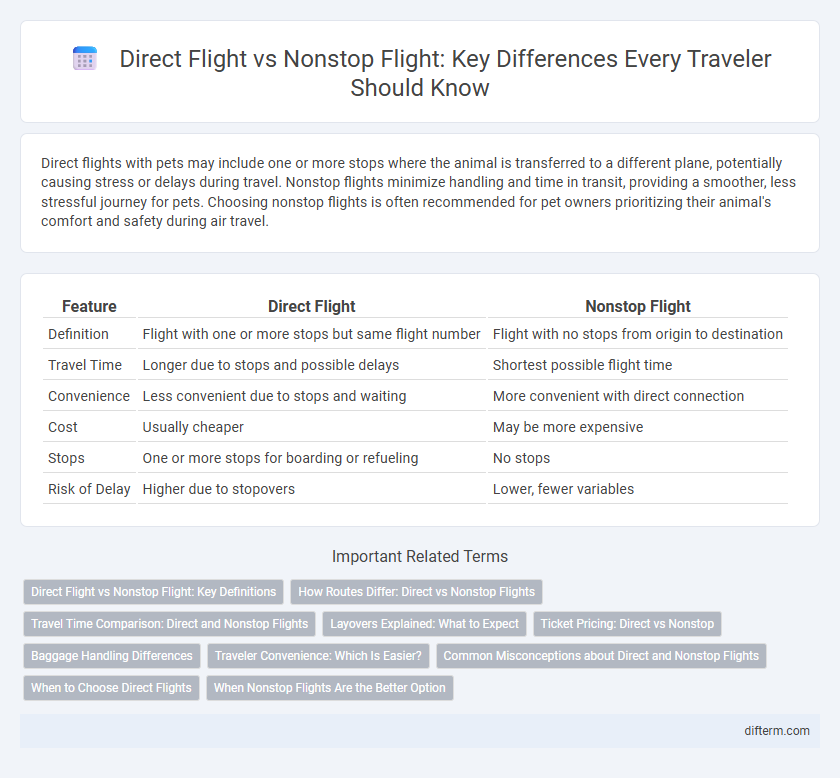Direct flights with pets may include one or more stops where the animal is transferred to a different plane, potentially causing stress or delays during travel. Nonstop flights minimize handling and time in transit, providing a smoother, less stressful journey for pets. Choosing nonstop flights is often recommended for pet owners prioritizing their animal's comfort and safety during air travel.
Table of Comparison
| Feature | Direct Flight | Nonstop Flight |
|---|---|---|
| Definition | Flight with one or more stops but same flight number | Flight with no stops from origin to destination |
| Travel Time | Longer due to stops and possible delays | Shortest possible flight time |
| Convenience | Less convenient due to stops and waiting | More convenient with direct connection |
| Cost | Usually cheaper | May be more expensive |
| Stops | One or more stops for boarding or refueling | No stops |
| Risk of Delay | Higher due to stopovers | Lower, fewer variables |
Direct Flight vs Nonstop Flight: Key Definitions
Direct flights involve one or more stops but do not require passengers to change planes, allowing a continuous journey on the same aircraft. Nonstop flights travel from the departure airport to the destination without any stops or layovers, offering the fastest and most straightforward option. Understanding these distinctions helps travelers optimize their itinerary based on convenience, travel time, and personal preferences.
How Routes Differ: Direct vs Nonstop Flights
Direct flights may include one or more stops where passengers remain on the plane or change aircraft without leaving the airport, often extending total travel time due to layovers. Nonstop flights maintain a continuous route between the origin and destination without any stops, offering faster travel and reduced inconvenience. Understanding these differences helps travelers optimize itineraries based on time efficiency and convenience.
Travel Time Comparison: Direct and Nonstop Flights
Nonstop flights offer the fastest travel time by flying directly from departure to arrival without any stops, significantly reducing total journey duration. Direct flights may include one or more stops but maintain the same flight number, which can extend travel time due to layovers or refueling. Travelers prioritizing efficiency should opt for nonstop routes to minimize delays and maximize convenience.
Layovers Explained: What to Expect
Direct flights may include one or more layovers where passengers remain on the same aircraft or switch planes, potentially extending travel time without leaving the airport. Nonstop flights fly from origin to destination without any layovers, offering the shortest possible travel duration and minimizing inconvenience. Understanding layovers involves recognizing that they can affect baggage handling, boarding procedures, and overall travel experience depending on the airline's policies and routing.
Ticket Pricing: Direct vs Nonstop
Nonstop flights typically command higher ticket prices due to their convenience and reduced travel time, often appealing to business travelers and those seeking efficiency. Direct flights, which may include layovers or stops without changing planes, usually offer more affordable options but can result in longer overall travel times. Airlines price these options based on demand, fuel costs, and operational complexity, influencing travelers' choices between cost and convenience.
Baggage Handling Differences
Direct flights may involve layovers where baggage is transferred between multiple flights, increasing the risk of delays or lost luggage. Nonstop flights transport baggage directly from departure to arrival without intermediate handling, minimizing the chance of mishandling or delays. Choosing nonstop flights typically ensures more reliable baggage handling and faster luggage retrieval upon arrival.
Traveler Convenience: Which Is Easier?
Direct flights involve one or more stops where passengers may change planes, potentially increasing travel time and hassle, whereas nonstop flights fly straight from departure to arrival without any stops, offering greater convenience. Travelers seeking ease benefit from nonstop flights that reduce the risk of missed connections and eliminate the need to navigate unfamiliar airports during layovers. Airlines often highlight nonstop routes for time efficiency and stress-free travel, making these flights the preferred choice for convenience-focused passengers.
Common Misconceptions about Direct and Nonstop Flights
Direct flights are often confused with nonstop flights, but they differ significantly in layover and travel time; nonstop flights travel from origin to destination without any stops, while direct flights may include one or more stopovers without changing planes. Many travelers mistakenly assume direct flights are faster or more convenient, yet nonstop flights usually offer shorter travel duration and less risk of delays. Understanding these distinctions helps passengers make informed decisions and optimize their travel plans.
When to Choose Direct Flights
Choose direct flights when minimizing travel time is crucial, as these flights have one or more stops but no plane changes, allowing for streamlined transitions. Opt for direct flights if you prefer flexibility in scheduling or need to access destinations not served by nonstop routes. Direct flights often offer a balance between total travel duration and cost efficiency, making them ideal for travelers seeking convenience without the commitment of nonstop itineraries.
When Nonstop Flights Are the Better Option
Nonstop flights are the better option when minimizing travel time and avoiding layover-related delays is a priority, especially for long-haul routes or tight schedules. These flights reduce the risk of missed connections and the hassle of changing planes, providing a smooth and efficient travel experience. Frequent flyers and business travelers often prefer nonstop flights to maximize productivity and comfort during their journey.
direct flight vs nonstop flight Infographic

 difterm.com
difterm.com